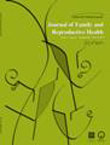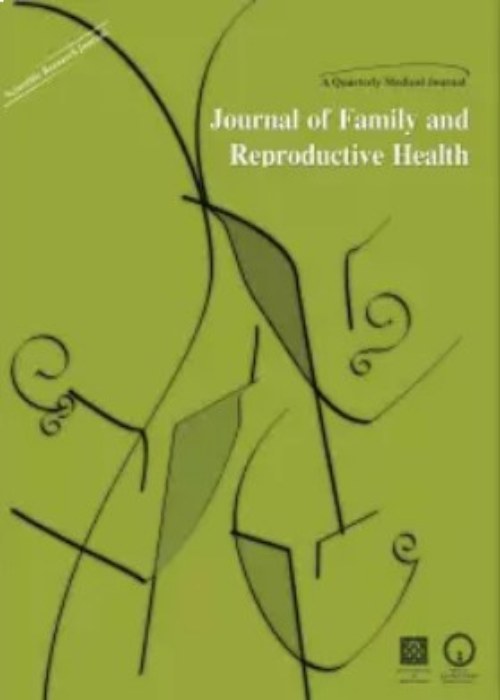فهرست مطالب

Journal of Family and Reproductive Health
Volume:9 Issue: 1, Mar 2015
- تاریخ انتشار: 1393/12/08
- تعداد عناوین: 8
-
-
Pages 1-4ObjectiveTo investigate the reproductive outcome of artificial endometrial preparation with exogenous steroids for frozen-thawed embryo transfer with and without pre-treatment with depot gonadotropin releasing hormone agonist (GnRH-a) in women with regular menses.Materials And MethodsThis is a prospective randomized clinical trial conducted in two ART centers on 176 women undergoing frozen-thawed embryo transfer. All patients received oral estradiol valerate 4 mg daily from day 2 to day 5 and 6 mg per day from day 6 to the day of the pregnancy test. In day 13 of cycle, an ultrasound examination was performed. After ultrasound confirmation of endometrial thickness (≥8 mm) and no ovarian activity, progesterone in cyclogest supp (800 mg daily) was added. The dose of estradiol would be increased to 8 mg per day if the endometrial thickness was less than 8mm. Two or 3 embryos were transferred via transcervical route 48 hours after the beginning of progesterone administration. In group A (93 patients), Difereline (3.75 mg Im), as a depot GnRH agonist was administered in the midluteal phase (day 21) of previous cycle. In the other group B (n = 83) steroid supplementation was commenced without prior pituitary suppression. Chemical and clinical pregnancy rates were compared in two groups.ResultsNo significant differences were seen between two groups in terms of chemical pregnancy and clinical pregnancy rates.ConclusionThe findings support the artificial protocol without any pretreatment suppressive drugs to reduce the adverse side effects of GnRH agonists also to minimize the costs.Keywords: frozen, thawed embryo transfer, GnRH agonist, artificial cycle, endometrial preparation, pregnancy outcome
-
Pages 5-11ObjectiveTo compared serum CRP levels and biochemical relation in PCOS patients with normal Iranian women.Materials And MethodsThis case-control study was performed on 52 individuals with PCOS (Rotterdam 2003 criteria). The cases were compared to 104 healthy non-PCOS, 20 to 35-year-old female subjects with no history of diabetes or renal diseases. Blood samples were taken on the 2nd to the 5th day of menstrual cycle for the evaluation of CRP levels, triglyceride, insulin, androstronedion, testestrone and total cholesterol.ResultsThe mean CRP was 1.38 (± 0.43) mg /dl in the PCOS group, and 1.08 (± 0.49) mg /dl (p= 0.240) in control group.High-Sensitivity C-Reactive Protein (HS-CRP) was positively correlated with the Body Mass Index (BMI) (r = 0.36, p= 0. 001). Before adjusting for age and BMI, CRP was correlated with LDL (r= 0.16, p= 0.03), total cholesterol (TC) (r= 0.17, p= 0. 03), Triglycerid (TG) (r= 0.23, p= 0.003), and the insulin (r= 0.20, p= 0. 01) notably in PCOS group. However, after adjustment was made for age and BMI, the correlation was attenuated in PCOS. The regression analyses depicted that CRP level was not under the influence of other medical parametersConclusionThe results showed that mean CRP level was not significantly different between PCOs and normal women. After adjustment for age and BMI, CRP was not associated with any biochemical marker evaluated in this study. It seems that studied biochemical serum levels were mostly associated with obesity. So reduction of BMI may normalize the serum levels of CRP and other biochemical parameters.Keywords: Female infertility, CRP, Polycystic ovary syndrome (PCOS)
-
Pages 13-18ObjectiveTo compare the effect of the physiologic and facilitated labor on the mother and neonate outcomes in the prim gravid women referring to Arash Hospital.Materials And MethodsThis clinical trial study was performed on 200 low risk pregnant women referring to Arash Women’s Hospital in 2012-2013. Mothers were divided into two groups of 100 patients using a simple random sampling method. The first group received the on-pregnancy and physiologic labor training and the second group was nominated for facilitated labor without training. The mother and neonate outcomes in these two delivery methods were then compared.ResultsThe rate of cesarean section in the physiologic group was significantly lower compared with the intervention group (p=0.001). Also in the first stage of labor, VAS was measured to be noticeably lower in the physiologic group in comparison with the intervention group (p=0.001), while the difference of VAS between the two studied groups was found not to be significant in the second stage of labor. In terms of duration of the labor and neonatal Apgar score two groups were not considerably different (p>0.05). Moreover, the laceration rate in the physiologic group was determined to be noticeably higher as compared to the intervention group (p=0.001). The groups were considerably different in terms of the vaginal bleeding and maternal satisfaction (p=0.001).ConclusionThis study revealed the lower rate of cesarean section, abnormal vaginal bleeding and pain score in the physiologic group compared with the facilitated group. Moreover, mothers of the first group were more content with the labor process.Keywords: Physiologic labor, facilitated labor, mother outcomes, neonate outcomes
-
Pages 19-21ObjectiveTo evaluate the ability of lidocaine local injection to relieve postoperative pain in cesarean delivery.Materials And MethodsThis double blinded clinical trial was conducted in a university on 100 women underwent elective cesarean section during March 2012 till March 2013. Patients were divided to two groups with random block method (n= 50 in each group). First group received 4mg/kg lidocaine 2% and its volume was titrated to 30 cc with distilled water. Second group received 30 cc of normal saline. Injections were done in different layers of abdominal wall. Visual analogue scale (VAS) was applied to record 12 hours severity of pain in all patients. Data were analyzed by SPSS software using one way ANOVA parametric test.ResultsVAS average was 4/13 in lidocaine group and 4/81 in placebo group. The need for analgesic use was 300 mg in lidocaine and 346 mg in normal saline patients and the difference was significant (p<0.000).ConclusionLocal use of lidocaine 2% in cesarean incision reduced post operative pain and need to use analgesic agents.Keywords: lidocaine 2%, cesarean section, VAS
-
Pages 23-28ObjectiveTo compare the effects of aerobic and stretching exercises on severity of primary dysmenorrhea.Materials And MethodsThis randomized clinical trial was conducted on 105 female students who were suffering from primary dysmenorrhea. The participants were divided into aerobic exercise, stretching exercise, and control groups. The two intervention groups did the exercises three times a week for eight weeks (two menstrual cycles). The intensity of dysmenorrhea was determined using a modified questionnaire that assessed several symptoms of dysmenorrhea. After all, the data were compared between and within groups through analysis of variance.ResultsBefore the intervention, the mean intensity of dysmenorrhea was 40.38±5.5, 37.40±3.8, and 38.45±3.3 in aerobic, stretching, and control groups, respectively, but the difference was not statistically significant. After the intervention, however, a significant difference was found among the three groups regarding the mean intensity of dysmenorrhea in the first and second menstrual cycles. Also, a significant difference was observed between the aerobic group and the control group as well as between the stretching group and the control group. Within group comparisons showed a significant difference in the aerobic and the stretching group before and after the interventions. However, no such difference was observed in control group.ConclusionBoth aerobic and stretching exercises were effective in reducing the severity of dysmenorrhea. Therefore, women could choose one of these two methods with regard to their interest and lifestyle.Keywords: Primary dysmenorrhea, Aerobic exercise, Stretching exercise, Exercise
-
Pages 29-33ObjectiveTo study the role of preoperative intravenous magnesium sulphate in decreasing post-cesarean pain and opioid requirement during first 24hrs.Materials And MethodsIn a double blind randomized clinical trial, prior to induction of general anesthesia, fifty elective cesarean candidates were randomly assigned to one of the two groups of placebo or magnesium sulfate. After surgery visual analogue scale (VAS) and infused morphine by PCA during 24 hrs were recorded. The data were analyzed by mann-Whitney -test, analysis of variance, and student t- test.ResultsVAS was significantly lower among patients in the magnesium sulphate group at intervals of 1st, 6th & 12th hours after cesarean section (C/S) with the mean scales of (48.9± 19.6 VS 74.7± 18.4), (42.1± 0.9 VS 58.3± 16.5) and (25.2± 6.1VS 30± 8.1) respectively and p-value of <0.001, 0.002 and 0.05 respectively. However at 24 hrs there was no significant difference in VAS with mean VAS scales of 22.6± 4.5 VS 23.6± 4.9 and p-value of 0.49. The dose of infused Morphine during 24 hrs was significantly less in the magnesium sulphate group than the placebo group with the means of 4.36± 1.4 VS 7.02± 1.9 mg respectively (p<0.001).ConclusionAdministration of bolus 50 mg/kg magnesium sulphate prior to induction of general anesthesia may significantly decreased the morphine requirement during immediate post operative period and can be recommended as one of the modalities of post-operative pain control in the pregnant patients.Keywords: Magnesium sulfate, Opioid, Cesarean, Pain, General anesthesia
-
A Comparative Study on Knowledge about Reproductive Health among Urban and Rural Women of BangladeshPages 35-40ObjectiveTo compare the level of knowledge on reproductive health among urban and rural women of selected area of Bangladesh.Materials And MethodsA descriptive cross-sectional study was undertaken among 200 women selected purposively from different rural and urban areas of Bangladesh. Data were collected using a semi-structured interviewer-administered questionnaire by face to face interview. Knowledge level was analyzed according to poor, moderate and good knowledge by pre-defined knowledge scoring.ResultsMean age of the respondents was 26 years and majority (66%) of them was housewives. Most of them (61%) had completed their primary level education. Around three-fourth of them belongs to lower-middle income group. Overall level of reproductive health knowledge was more evident among urban reproductive aged women than rural counterparts (p<0.001). Moreover, significant knowledge gap was found regarding family planning (p= 0.005), care during pregnancy (p <0.001), safe motherhood (p= 0.002), newborn care (p= 0.009) and birth spacing (p <0.001) between urban and rural women. Family members were the major source of information in both groups.ConclusionA wide knowledge gap was found between Bangladeshi urban and rural respondents regarding their reproductive behaviors. Government and concerned organizations should promote and strengthen various health education programs to focus on reproductive health, especially among reproductive aged women in rural area.Keywords: Knowledge, Reproductive Health
-
Pages 41-44ObjectiveTo report involvement of the central nervous system (CNS) following epithelial ovarian cancer is rare. Advances in management of ovarian cancer by use of primary surgery including abdominal hysterectomy, bilateral salpingo’oophorectomy should attain as complete a cytoreduction as possible and effective platinum-based chemotherapy have prolonged survival.Case report:We present a case involving a 35-year-old Iranian woman diagnosed and treated for primary ovarian cancer in 2002. She underwent optimal cytoreductive surgery and chemotherapy treatment. Eight months after the initiation of therapy, multiple brain metastases without intraperitoneal lesions were found and treated with combination chemotherapy and whole brain radiotherapy (WBRT), without evidence of recurrent disease. The patient died from disease in December 2005.ConclusionIn a patient suffering from neoplasm that rarely metastasizes to CNS, a careful clinical examination and proper therapeutic approach including chemotherapy may lead to prolong survival.Keywords: Ovarian Cancer, Brain Metastasis, Chemotherapy


